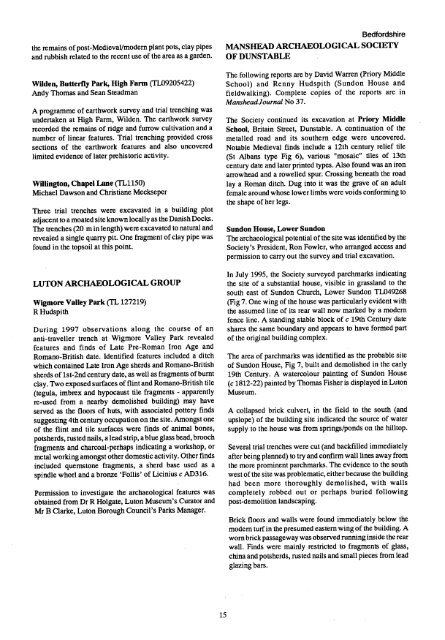CBA SMA\SMA 1998.PDF - Council for British Archaeology
CBA SMA\SMA 1998.PDF - Council for British Archaeology
CBA SMA\SMA 1998.PDF - Council for British Archaeology
You also want an ePaper? Increase the reach of your titles
YUMPU automatically turns print PDFs into web optimized ePapers that Google loves.
the remains of post-Medieval/modern plant pots, clay pipes<br />
and rubbish related to the recent use of the area as a garden.<br />
Wilden, Bufterfly Park, High Farm (TL09205422)<br />
Andy Thomas and Sean Steadman<br />
A programme of earthwork survey and trial trenching was<br />
undertaken at High Farm, Wilden. The earthwork survey<br />
recorded the remains of ridge and furrow cultivation and a<br />
number of linear features. Trial trenching provided cross<br />
sections of the earthwork features and also uncovered<br />
limited evidence of later prehistoric activity.<br />
Willington, Chapel Lane (TL1150)<br />
Michael Dawson and Christiane Meckseper<br />
Three trial trenches were excavated in a building plot<br />
adjacent to a moated site known locally as the Danish Docks.<br />
The trenches (20 m in length) were excavated to natural and<br />
revealed a single quarry pit. One fragment of clay pipe was<br />
found in the topsoil at this point.<br />
LUTON ARCHAEOLOGICAL GROUP<br />
Wigmore Valley Park (TL 127219)<br />
R Hudspith<br />
During 1997 observations along the course of an<br />
anti-traveller trench at Wigmore Valley Park revealed<br />
features and finds of Late Pre-Roman Iron Age and<br />
Romano-<strong>British</strong> date. Identified features included a ditch<br />
which contained Late Iron Age sherds and Romano-<strong>British</strong><br />
sherds of lst-2nd century date, as well as fragments of burnt<br />
clay. Two exposed surfaces of flint and Romano-<strong>British</strong> tile<br />
(tegula, imbrex and hypocaust tile fragments - apparently<br />
re-used from a nearby demolished building) may have<br />
served as the floors of huts, with associated pottery finds<br />
suggesting 4th century occupation on the site. Amongst one<br />
of the flint and tile surfaces were finds of animal bones,<br />
potsherds, rusted nails, a lead strip, a blue glass bead, brooch<br />
fragments and charcoal-perhaps indicating a worlcshop, or<br />
metal working amongst other domestic activity. Other finds<br />
included quernstone fragments, a sherd base used as a<br />
spindle whorl and a bronze `Follis' of Licinius c AD316.<br />
Permission to investigate the archaeological features was<br />
obtained from Dr R Holgate, Luton Museum's Curator and<br />
Mr B Clarke, Luton Borough <strong>Council</strong>'s Parks Manager.<br />
Bed<strong>for</strong>dshire<br />
MANSHEAD ARCHAEOLOGICAL SOCIETY<br />
OF DUNSTABLE<br />
The following reports are by David Warren (Priory Middle<br />
School) and Renny Hudspith (Sundon House and<br />
fieldwalking). Complete copies of the reports are in<br />
M anshead Journal No 37.<br />
The Society continued its excavation at Priory Middle<br />
School, Britain Street, Dunstable. A continuation of the<br />
metalled road and its southem edge were uncovered.<br />
Notable Medieval finds include a 12th century relief tile<br />
(St Albans type Fig 6), various "mosaic" tiles of 13th<br />
century date and later printed types. Also found was an iron<br />
arrowhead and a rowelled spur. Crossing beneath the road<br />
lay a Roman ditch. Dug into it was the grave of an adult<br />
female around whose lower limbs were voids con<strong>for</strong>ming to<br />
the shape of her legs.<br />
Sundon House, Lower Sundon<br />
The archaeological potential of the site was identified by the<br />
Society's President, Ron Fowler, who arranged access and<br />
permission to carry out the survey and trial excavation.<br />
In July 1995, the Society surveyed parchmarlcs indicating<br />
the site of a substantial house, visible in grassland to the<br />
south east of Sundon Church, Lower Sundon TL049268<br />
(Fig 7. One wing of the house was particularly evident with<br />
the assumed line of its rear wall now marked by a modern<br />
fence line. A standing stable block of c 19th Century date<br />
shares the same boundary and appears to have <strong>for</strong>med part<br />
of the original building complex.<br />
The area of parchmarks was identified as the probable site<br />
of Sundon House, Fig 7, built and demolished in the early<br />
19th Century. A watercolour painting of Sundon House<br />
(c 1812-22) painted by Thomas Fisher is displayed in Luton<br />
Museum.<br />
A collapsed brick culvert, in the field to the south (and<br />
upslope) of the building site indicated the source of water<br />
supply to the house was from springs/ponds on the hilltop.<br />
Several trial trenches were cut (and backfilled immediately<br />
after being planned) to try and confirm wall lines away from<br />
the more prominent parchmarks. The evidence to the south<br />
west of the site was problematic, either because the building<br />
had been more thoroughly demolished, with walls<br />
completely robbed out or perhaps buried following<br />
post-demolition landscaping.<br />
Brick floors and walls were found immediately below the<br />
modern turf in the presumed eastern wing of the building. A<br />
worn brick passageway was observed running inside the rear<br />
wall. Finds were mainly restricted to fragments of glass,<br />
china and potsherds, rusted nails and small pieces from lead<br />
glazing bars.<br />
15

















